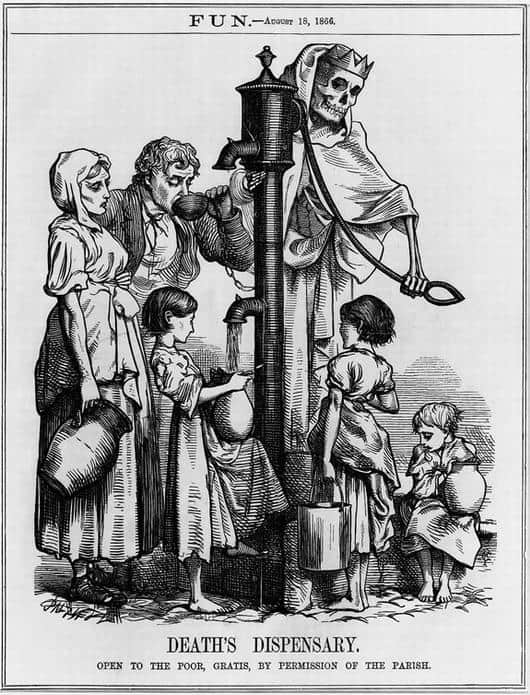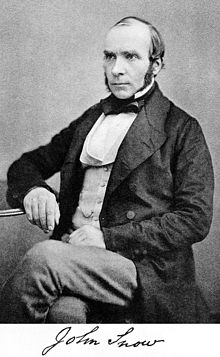London, England had a big problem in the mid-1800s. Cholera (a disease that causes an infection in the small intestine) was breaking out and spreading rapidly through poor sanitation. The cholera outbreak from 1848-49 killed approximately 54,000-62,000 in London, and the outbreak from 1853-54 killed an estimated 31,000 in the city.
Doctors at the time were operating under the “Miasma Theory”, the thought that illnesses were spread through poor quality air. From their perspective that made a lot of sense—rotten food smelled bad, and if you ate it you’d get sick—so it meant that a lot of preventative medicine was centred on cleaning up the city or appealing to a deity. Illnesses like cholera were frequently associated with being poor, impure, or lazy.
London was overcrowded and had many infrastructure problems that go along with large numbers of people. The sewers were often overworked and cesspits developed in the basements and backyards of houses, particularly in the poorer areas of the city. The government responded by dumping the waste from those cesspits into the River Thames, thereby making the river undrinkable, forcing the locals to get their water from pumps that were scattered in public squares all around the city. Despite this, some unscrupulous water pump companies continued to draw tainted water from the Thames.

One prominent London physician was Dr. John Snow. He was a doctor and anesthesiologist who was one of the first physicians to study the use of anesthetic in surgeries (a common practice today). He was also interested in the spread of disease, particularly cholera.

If the Miasma Theory was true, then sewer workers and people who worked closer to the river would have a higher likelihood of catching cholera, but Snow found that this wasn’t the case—something else had to be at work. In 1854 he decided that he was going to try and discover the cause of a new cholera outbreak, and through interviewing sick patients began to discover that they all got their water from the same local pump. He then took a map of the area and began placing a dot on the map where a case of cholera was reported. This map showed a concentration of cholera cases radiating out from a water pump located at the corner of Broad Street and Cambridge Street (now Lexington Street). It was found that this pump was dug too close to a cesspit which had already been contaminated with cholera and had been leaking contaminated material into the well. That map later became known as “The Ghost Map”.

Snow’s Ghost Map – Showing the Cholera Cases Around the Tainted Pump
There were some anomalies with the Ghost Map. Some families who lived further away from the pump said that they preferred the water from the Broad Street pump, and so had always asked for the water to be collected there. Other times, children who lived further away would have to pass by the Broad Street pump on the way to school and would stop for a drink as they went. At the same time, none of the workers at the nearby Broad Street Brewery contracted cholera, likely because they chose to drink beer instead of water.
Without really knowing what germs were, Snow determined that something was in the water making these people sick, and the government replaced the Broad Street pump, effectively ending the outbreak. John Snow and his Ghost Map have become known as one of the first modern studies of epidemiology (the study of epidemics).
Interested in learning more about Dr. Snow and the Cholera epidemic? Check out Steven Johnson’s great book, “The Ghost Map: The Story of London’s Most Terrifying Epidemic – And How it Changed Science, Cities, and the Modern World.”
Or, better yet, visit the “John Snow Pub” located on the original site of the Broad Street Pump:
